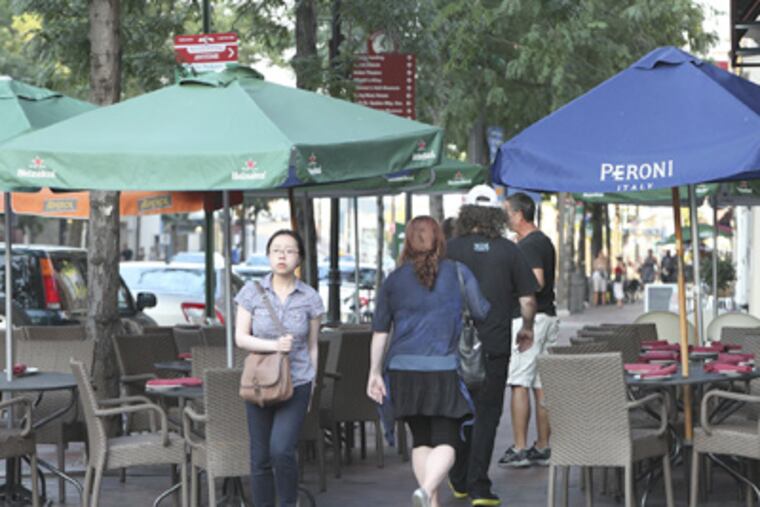Sidewalk cafes don't leave much walking room
Summertime, when the living is easy … But not for pedestrians in happening parts of town.

Summertime, when the living is easy …
But not for pedestrians in happening parts of town.
We are enjoying the annual blooming of picturesque sidewalk cafés, which enrich some environments, but can illegally spread like kudzu to strangle sidewalks. Too many restaurants ignore the law with near-impunity.
The "law" is the Philadelphia Code, enforced by the Streets Department, but "enforced" is an overstatement.
The code says sidewalks with a width of 13 feet or less require "five feet of clear sidewalk space." That means no obstructions such as parking meters, trees, poles, fire hydrants, etc. On sidewalks wider than 13 feet, "at least one-half" of the sidewalk must be clear for pedestrians.
The purpose of the law is to keep sidewalks safe for pedestrians. Sidewalks should not be the obstacle courses that some restaurants turn them into.
"We do two 'sweeps' a year" to look for violations, says David Perri, Streets Department deputy commissioner for transportation. While sidewalk cafés have mushroomed from 239 in 2009 to 399 this year, Streets has no staffers dedicated to sidewalk-café enforcement.
In 2010, 194 inspections were done and 17 tickets written. The next year, following my September column on the subject, there were 445 inspections and 90 tickets. So far this year, the pace is slower — 125 inspections and 15 tickets.
The department responds to complaints, adds Perri, which should come in through 3-1-1. That's the theory.
While walking around town, "lifelong pedestrian" Bob Arrington noticed that Amis, at 412 S. 13th, actually sank counter table legs into the sidewalk. Is that legal? He called 3-1-1, got a docket number and, after some time passed, he checked back and found the case was "completed," but got no idea of the outcome. So he called me, otherwise known as 6-6-6.
I jumped to Streets for some answers, and got some hope for the future, but first — Amis.
It is not legal. The restaurant got a $75 ticket on Thursday and Perri gave it three weeks to get into compliance.
Amis manager Martin Cugine tells me he installed the narrow counters, rather than tables, to leave more space for pedestrians, unaware he was breaking the law. He promises the problem will be fixed fast. "I'm on your side," he says. "We want to be a better neighbor." It's really just good manners.
For the future, Perri tells me Streets is "working with the Law Department to draft a new ordinance and technical regulations," to make the "rules more clear, make them easier to enforce and obtain a higher degree of compliance." They don't seem especially dense now, but OK.
One idea is to have brass markers in the sidewalk, installed at the restaurant's expense, to show precisely where tables can go. Another would be a posted floor plan, "so everyone is aware of the area that's allowed to be used for the sidewalk café," Perri says, adding there's a "delicate balance" between a pedestrian's rights and a restaurant's needs.
Currently, a restaurant not in compliance gets a $75 ticket, which does not escalate with repeat offenses.
That's laughable, says Arrington. "A $75 ticket does nothing, they make that up in one night." I agree.
What would you do? I ask Arrington, who has no beef with outdoor cafés when they play by the rules.
If they break the rules, "they lose their café privilege for a week or a month," he says. That would bite more than $75.
Sidewalk café permits cost $175 and they are a privilege, not a right, says Perri. They can be revoked.
And should be, if that's what it takes to get restaurants to obey the rules of safety and, let's face it, just good manners.